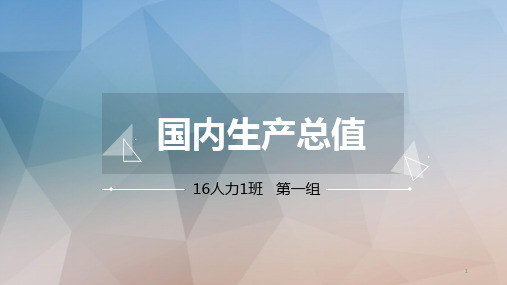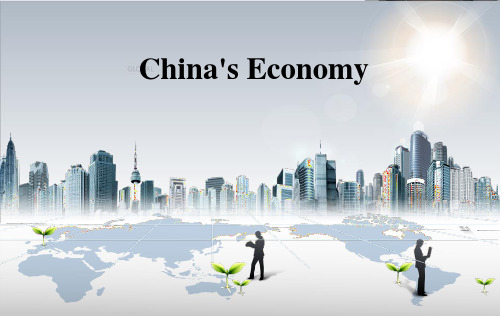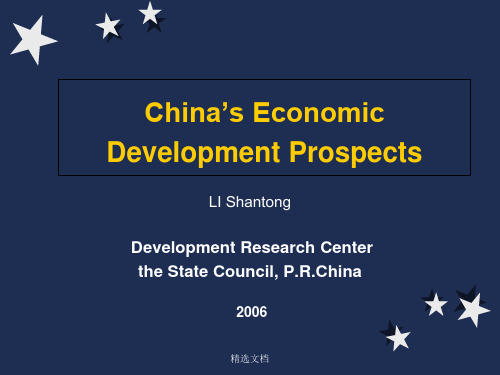中国当前经济状况,英文PPT
- 格式:pptx
- 大小:2.15 MB
- 文档页数:10

中国经济现状与趋势分析**China's Economic Status Quo and Future Trends****Introduction**As the world's second-largest economy, China's economic performance and prospects have garnered global attention. From its rapid industrialization and urbanization in recent decades to its current status as a leading player in global trade and investment, China's economic journey has been nothing short of remarkable. This paper aims to delve into China's current economic status and identify key trendsthat are shaping its future.**Current Status of China's Economy*** **Growth and Development**: China's economy has experienced rapid growth in recent years, with GDP expanding at an average annual rate of over 6%. This growth has been driven by various factors, including industrialization, urbanization, and a vast labor force. China has also made significant progress in reducing poverty and improving living standards. * **Trade and Investment**: China is a key player in global trade, withits exports and imports accounting for a significantportion of the world's total. The country has also been actively investing in other countries, seeking to expandits economic influence and access new markets. ***Structural Changes**: In recent years, China has been undergoing significant structural changes in its economy. This includes a shift from a reliance on low-cost manufacturing to a more innovation-driven model, as well as a focus on green and sustainable development.**Future Trends Shaping China's Economy*** **Digitalization and Technology**: With the rapid development of digital technology, China is poised to lead the way in digitalization and innovation. The country has already made significant investments in areas such as 5G, artificial intelligence, and blockchain, which are expected to drive future economic growth. * **Consumer-Driven Growth**: As China's middle class continues to expand, consumer demand is expected to drive economic growth. This shift towards a consumer-driven economy will require companies to innovate and adapt to changing consumer preferences. * **Green Development**: With environmentalsustainability becoming a global priority, China is prioritizing green development. This includes investing in renewable energy, promoting eco-friendly production methods, and implementing strict environmental regulations. ***Global Integration**: China is increasingly integrating with the global economy, seeking to expand its influenceand access new markets. This trend is expected to continue, with China playing a key role in global trade and investment.**Conclusion**China's economy has undergone remarkable transformation in recent decades, and the future looks promising. With a focus on digitalization, consumer-driven growth, green development, and global integration, China is poised to continue its economic rise and play a pivotal role in the global economy. However, challenges such as structural imbalances, environmental degradation, and socialinequality need to be addressed to ensure sustainable and inclusive economic growth.**中国经济现状与趋势分析**中国作为世界第二大经济体,其经济绩效和前景一直备受全球关注。


中国经济的现状与趋势英语作文China's economy has been a powerhouse of global growth, with a remarkable transformation over the past few decades. The country has shifted from a predominantly agrarian society to a leading industrial and technological force.The current state of China's economy is characterized by robust manufacturing, a thriving service sector, and arapidly expanding consumer base. Despite facing challenges such as an aging population and environmental concerns, China continues to innovate and adapt its economic strategies.One of the key trends is the shift towards a more sustainable and consumption-driven economy. The government is investing heavily in green technologies and renewable energy, aiming to reduce carbon emissions and combat climate change.Technological advancements are also shaping China's economic landscape. The rise of e-commerce, artificial intelligence, and 5G networks is creating new opportunities and challenges for businesses and consumers alike.Another notable trend is the Belt and Road Initiative, which seeks to enhance global trade and infrastructure development. This ambitious project is expected to bolster China's international economic influence and foster closer ties with partner countries.However, the global economic landscape is dynamic, and China is not immune to external shocks. The ongoing trade tensions and the COVID-19 pandemic have tested the resilience of its economy, prompting the government to implement stimulus measures and reform policies.In conclusion, China's economy is at a crossroads, with the potential for continued growth and prosperity. Its future trajectory will depend on how effectively it can navigate the complexities of the global economy and address domestic challenges.。


中国经济的现状与趋势英语作文全文共3篇示例,供读者参考篇1The Current Situation and Trends of China's EconomyChina, as one of the largest economies in the world, has experienced tremendous growth and development over the past few decades. With a population of over 1.4 billion people and a rapidly expanding middle class, the country has become a major player in the global economy. In this essay, we will examine the current state of China's economy and discuss some of the key trends that are shaping its future.The Current SituationChina's economy has been growing at an impressive rate for the past few decades, with an average GDP growth rate of around 9% per year. This growth has been driven by a number of factors, including a large and productive workforce, a strong export sector, and a booming consumer market. The country has also invested heavily in infrastructure and technology, which has helped to fuel its rapid economic expansion.In recent years, however, China's economy has begun to show signs of slowing down. Growth rates have dipped below 7% in some years, and there are concerns about rising debt levels and a slowing property market. The government has introduced a number of measures to try and boost growth, including interest rate cuts and tax incentives for businesses. Despite these efforts, the economy is still facing some challenges, and it remains to be seen how they will be addressed in the coming years.The TrendsOne of the key trends that is shaping China's economy is the shift towards a more consumer-driven model. In the past, the country's growth was driven largely by exports and investment, but in recent years there has been a growing emphasis on domestic consumption. This trend is being driven by rising incomes, urbanization, and a growing middle class, all of which are fueling demand for goods and services.Another important trend is the government's push towards innovation and technological development. China has set ambitious goals for becoming a world leader in areas such as artificial intelligence, robotics, and renewable energy. The government has invested heavily in research and development,and has introduced a number of policies to support innovation, such as tax breaks and subsidies for high-tech industries.In addition to these trends, China's economy is also facing challenges in the form of rising debt levels, environmental degradation, and an aging population. The country's debt levels have been growing rapidly in recent years, and there are concerns about their sustainability. The government has introduced measures to try and address this issue, such as cracking down on shadow banking and tightening regulations on lending.Environmental degradation is another major challenge facing China's economy. The country has one of the highest levels of pollution in the world, and this is taking a toll on public health and quality of life. The government has introduced a number of measures to try and tackle this issue, such as investing in renewable energy and implementing stricter environmental regulations.Finally, China is also facing the challenge of an aging population. The country's one-child policy, which was in place for several decades, has led to a rapidly aging population and a shrinking workforce. This is putting pressure on the country'ssocial welfare system and could potentially impact economic growth in the long term.ConclusionIn conclusion, China's economy is at a critical juncture, with a number of challenges and opportunities on the horizon. While the country has achieved impressive growth and development in recent years, there are concerns about its sustainability and the impact of factors such as rising debt levels, environmental degradation, and an aging population. The government will need to continue to implement policies that support innovation, encourage domestic consumption, and address these challenges in order to ensure the long-term health and prosperity of China's economy.篇2The Current Situation and Future Trend of Chinese EconomyIntroductionChina has experienced remarkable economic growth and development over the past few decades, transforming itself from a poor agrarian economy to a global economic powerhouse. With a population of over 1.4 billion people and a rapidly modernizing economy, China plays a significant role in theglobal economy. In this essay, we will discuss the current situation and future trend of the Chinese economy.Current SituationChina is the world's second-largest economy, with a GDP of over $13 trillion. The country has made significant progress in various sectors, including manufacturing, technology, and finance. However, China also faces several challenges, such as income inequality, environmental pollution, and an aging population.The Chinese government has implemented various policies to address these challenges, such as reducing pollution, promoting innovation, and investing in social welfare programs. Despite these efforts, China continues to face economic and social challenges.Future TrendChina's economy is expected to continue growing in the coming years, albeit at a slower pace. The government has set a target of achieving a "moderately prosperous society" by 2021 and becoming a "fully developed nation" by 2049. To achieve these goals, China will need to address several key issues, such as economic restructuring, innovation, and social equality.One of the key challenges facing China's economy is the need for economic restructuring. The country's economy has been driven by exports and manufacturing for many years, but it now needs to shift towards a more consumption-driven model. This will require China to invest in consumer goods, services, and technology.Innovation is another key factor that will drive China's future economic growth. The country has made significant progress in areas such as artificial intelligence, biotechnology, and renewable energy. To maintain its competitive edge, China will need to continue investing in research and development.Social equality is also a crucial issue for China's future economic development. The country has made progress in reducing poverty and improving living standards, but income inequality remains a significant concern. The government will need to implement policies that promote social welfare, education, and healthcare to ensure that all Chinese citizens can benefit from economic growth.ConclusionIn conclusion, China's economy is at a critical juncture, with both opportunities and challenges. The country has made significant progress in various sectors, but it also faces severalkey issues that need to be addressed. By implementing the right policies and investing in innovation and social welfare, China can continue to grow and remain a global economic powerhouse.篇3The Current Situation and Trends of the Chinese EconomyChina, as the world's second largest economy, has been experiencing rapid growth and transformation over the past few decades. The country has gone through significant changes, from a predominantly agrarian society to a global economic powerhouse. In this essay, we will examine the current state of the Chinese economy and its future trends.The Chinese economy has been growing at an impressive rate for the past few decades, with an average annual GDP growth rate of around 10%. This growth has been fueled by a number of factors, including a massive influx of foreign direct investment, a large pool of cheap labor, and a rapid expansion of the manufacturing sector. However, in recent years, the Chinese economy has faced a number of challenges, including rising labor costs, an aging population, and a slowdown in global demand.One of the key trends in the Chinese economy is the shift from an export-led growth model to a more consumption-driven model. In recent years, the Chinese government has been implementing a number of measures to boost domestic consumption, including increasing wages, providing social welfare benefits, and investing in infrastructure. This shift is expected to reduce China's reliance on exports and make the economy more resilient to external shocks.Another trend in the Chinese economy is the rise of the service sector. In recent years, the service sector has been growing at a faster rate than the manufacturing sector, driven by rising incomes and changing consumer preferences. This shift towards services is expected to create new opportunities for investment and job creation, as well as help to rebalance the economy towards consumption-led growth.One of the biggest challenges facing the Chinese economy is the issue of income inequality. Despite its rapid economic growth, China remains one of the most unequal countries in the world, with a large wealth gap between urban and rural areas, as well as between different regions. Addressing this issue will be crucial for ensuring the long-term stability and sustainability of the Chinese economy.In conclusion, the Chinese economy is at a critical juncture, facing a number of challenges and opportunities. While the country has made significant progress in recent years, there are still many hurdles to overcome in order to achieve sustainable and inclusive growth. By addressing key issues such as income inequality, shifting towards a consumption-driven model, and investing in the service sector, China can continue to thrive and contribute to global economic development.。

中国经济现状英语作文The Current Situation of Chinese EconomyIn recent years, China has undergone significant economic growth and transformation. With a GDP growth rate of 6.1% in 2019, China remains one of the world's fastest-growing major economies. However, as the world's second-largest economy, China faces a number of challenges that are shaping its current economic landscape.One of the key issues facing the Chinese economy is the ongoing trade war with the United States. The trade tensions between the two countries have resulted in tariffs being imposed on billions of dollars worth of goods, disrupting global supply chains and impacting both countries' economies. As a result, China's export sector has been negatively affected, leading to a decrease in exports and a slowdown in economic growth.Another challenge facing the Chinese economy is the high level of debt. China's total debt-to-GDP ratio is estimated to be around 300%, which is significantly higher than the global average. The high level of debt is a major concern for policymakers, as it poses risks to financial stability and economic growth. In order to address this issue, the Chinese governmenthas implemented various measures to deleverage the economy and reduce financial risks.Furthermore, China is also facing demographic challenges, with an aging population and a shrinking workforce. The country's working-age population has been declining in recent years, as a result of its one-child policy and changing demographics. This demographic change will have implications for the economy, including a potential decline in productivity and consumption.Despite these challenges, China has made significant progress in transitioning towards a more consumer-driven economy. Consumption has become a key driver of economic growth, as the Chinese government seeks to rebalance the economy away from its reliance on investment and exports. In addition, China has been investing heavily in technology and innovation, in order to drive economic growth and improve competitiveness.In conclusion, the Chinese economy is at a crossroads, facing a number of challenges as it seeks to maintain its growth momentum and address structural imbalances. The Chinese government has implemented various policies to address these challenges, including efforts to deleverage the economy, boostconsumption, and promote innovation. It remains to be seen how these policies will impact the economy in the long term, but China's economic trajectory will continue to be closely watched by policymakers and analysts around the world.。
中国经济现状英语作文Title: The Current Situation of Chinese EconomyIntroductionIn recent years, China has become one of the world's leading economies, experiencing rapid growth and development. With a population of over 1.4 billion people, China has utilized its vast resources and market potential to become a major player in the global economic arena. However, like all economies, China faces various challenges and opportunities in maintaining its economic growth and stability. This essay will provide an overview of the current situation of the Chinese economy, analyzing its strengths, weaknesses, and potential future developments.Economic Growth and DevelopmentChina's economy has experienced remarkable growth over the past few decades, averaging around 6-7% annually. This growth has been driven by various factors, including government policies focused on industrialization, urbanization, andexport-led growth. China's manufacturing sector has played a crucial role in driving economic growth, leading to the country becoming known as the "world's factory".In recent years, China has also made significant strides in technology and innovation, with the government investing heavily in research and development. This has helped China become a global leader in various industries, such as electric vehicles, renewable energy, and e-commerce.Challenges Facing the Chinese EconomyDespite its impressive economic growth, China faces several challenges that could potentially hinder its future development. One of the most significant challenges is the country's rapidly aging population, which poses a threat to the country's labor force and productivity. Additionally, China faces growing environmental concerns, such as air and water pollution, which could have long-term negative effects on the economy.Furthermore, China's reliance on debt-fueled investment and state-led intervention in the economy has raised concerns about the sustainability of its growth model. The government's heavy-handed approach to regulating the economy has also led to issues such as overcapacity, financial risks, and lack of market efficiency.Future Prospects and OpportunitiesDespite these challenges, China still has numerous opportunities for future economic growth and development. The country's shift towards a more consumption-driven economy presents opportunities for domestic and foreign businesses alike. With an expanding middle class and increasing disposable income, China's consumer market has become one of the largest in the world.Moreover, China's ambitious Belt and Road Initiative (BRI) aims to enhance connectivity and cooperation among countries in Asia, Africa, and Europe, providing new opportunities for trade, investment, and infrastructure development. The BRI has the potential to boost economic growth in China and its partner countries, creating a win-win situation for all parties involved.ConclusionIn conclusion, the current situation of the Chinese economy is characterized by rapid growth, technological innovation, and increasing global influence. While the country faces challenges such as an aging population, environmental degradation, and debt overhang, it also has opportunities for future economic growth through consumption-led expansion, BRI initiatives, and technological advancements. By addressing these challenges and seizing these opportunities, China can continue to maintainits status as one of the world's leading economies in the years to come.。